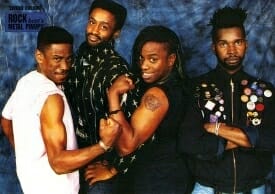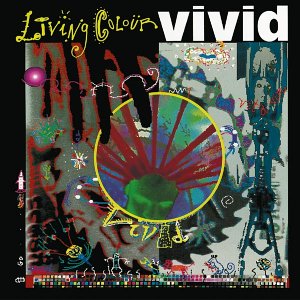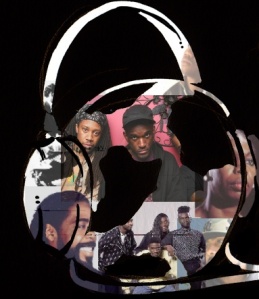 By shelz.
By shelz.
In the late 80’s, the musical lines of ethnic demarcation were obvious. Rap and R&B were typically black. Rock was typically white. And outside of The Beastie Boys’ Rock-Hop hybrid, Licensed to Ill or the Aerosmith/Run-DMC sonic mulatto known as “Walk This Way,” musicians normally stayed in separate lanes. That was until some neophyte rockers rose from the Hip-Hop drenched concrete of New York City and laid waste to the idea that rock was strictly for the melanin challenged. With their eclectic mix of hard rock, funk, jazz and Hip-Hop, Living Colour redefined not only the 80’s rock sound, but the image of the rock band.
The group was the brainchild of guitarist Vernon Reid, an active member of the New York jazz scene in the early 80’s. He auditioned several musicians before he found three other members (Corey Glover-vocals, Will Calhoun-drums and Muzz Skillings-bass) who blended seamlessly into the sound he wanted. The critics immediately branded the band “unique” because of their race, but the differences between Living Colour and their contemporaries went far beyond skin color.
After finding a fan in Mick Jagger from the Rolling Stones the quartet secured a deal with Epic Records thanks, in part, to a Jagger-produced demo. A year later they dropped their freshman album, the aptly titled, Vivid. The band pulled from all of their influences, creating one of the most eclectic rock albums of the decade. Reid’s screeching guitar riffs were tempered by Glover’s gloriously soulful voice and the rhythm section was rounded out by Skilling’s agile, funk possessed bass lines and Calhoun’s perfect timing and penchant for brilliant improvisation. All students of music and instrumentation, the members of Living Colour were technically superior to the rock gods they competed against. The unusual combination of genres added depth to Colour’s sound, but as lush as the tracks were, they were still eclipsed by the profundity of Reid’s lyrics. While Poison was begging girls to talk dirty to them and Motley Crue was smoking in the boys room, Living Colour was dealing with an array of serious subjects from gentrification to racism.
The first single released from Vivid, “Cult of Personality,” was a fiery indictment of world leaders and their exploitation of the masses. On its heels was the more melodic “Open Letter to a Landlord,” a poignant look at the devasting effects of gentrification. The album also featured Chuck D and Flava Flav on the funk laden, “Funny Vibe.”  The song was a message to anyone who crossed the street or clutched their pearls when they saw a black man coming that the fear simply wasn’t necessary.
The song was a message to anyone who crossed the street or clutched their pearls when they saw a black man coming that the fear simply wasn’t necessary.
Vivid began a slow creep up the charts but the release of the music video for “Cult of Personality” sky-rocketed the band into the celebrity stratosphere. The album found itself in the double-platinum range and the band was hired as the opening act for The Rolling Stones Steel Wheels/Urban Jungle Tour.
Fresh off the success of their first album which produced two Grammy nominations and one win for Best Hard Rock Performance for “Cult of Personality,” the group started on their second release, Time’s Up. Even more experimental and diverse than their debut album, Time’s Up found the musicians spreading out with a full spectrum of genre inclusions and a heavier feature roster including Maceo Parker, Little Richard, Queen Latifah and Doug E. Fresh. The album did not sell as well as Vivid, but it was received well by critics and earned the rockers their 2nd Grammy for Best Hard Rock Album. The intensity was ratcheted up exponentially. The passion was amplified and the depth and insight of the lyrical content almost made Vivid sound like Dick and Jane.
The band angrily explored the crumbling inner cities, rogue cops and teenage pregnancy in “Someone Like You.” They tackled the media’s exaggeration of both the career and legacy of Elvis Presley in “Elvis is Dead.” Glover’s apocalyptic rants on the title track were carried to unnerving heights by the thrash rock back drop. Times Up was loud, boisterous, effectual phonic anarchy, but the band was perfectly cohesive and the album is one of the best rock performances ever recorded.

Not long after the release of their second LP, Muzz Skillings quit due to creative differences and was replaced by Doug Wimbish, one of the original bassists at Sugar Hill Records. The band then released their third LP, Stain. Dark and moody, Stain was even more aggressive than their previous LP’s. While this album was again well received by the critics, sales were poor compared to the previous two and the band split completely after failing to agree on the creative direction of their fourth album.
After an eight year split that produced a plethora of solo projects, the band regrouped in 2003 releasing the much anticipated Collideøscope and are currently working on a new album, Chair in the Doorway. Only time will tell if their next release will put them back on the path to the mass fan acceptance and platinum plaques of their 80’s heyday, but it’s already obvious that they still tower technically over their rock peers. With the cross-cultural display of most musical genres today, the group is now awash in their own legacy. So expect the band to kick in the door and bring the music full circle. It’s time for their contemporaries and fans alike to prepare for the return of the architects because the new millennium scene is truly the house that Living Colour built.
Celebrate Black Music Month With Planet Ill
Follow Us on Twitter @ http://twitter.com/planetill
Follow shelz. @ http://twitter.com/shelzp
Join Us on the Planet Ill Facebook Group for more discussion





Elvis is not dead. Neither are all the influences that generated Living Color’s music. Elvis was a fan of all types of music. His synthesis of gospel, R&B, and pop music created a new sound. It and his preformance style challenged the public’s notion of what was acceptable at the time. The media continues to promote his legacy, but only because people keep responding to it.
In my novel, Trying to Get to You, I envision a band with an eclectic approach that is not easily categorized. Living Color takes my vision a steps further. I grew up with classic rock. So many musician have contributed to its evolution. Living Color takes it to a whole new level.